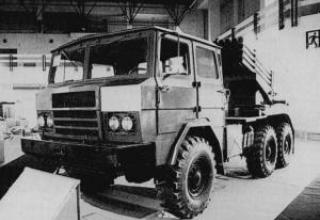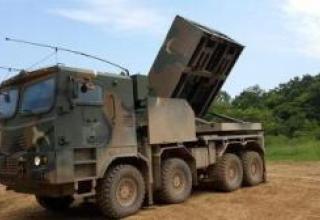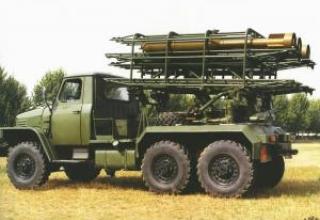Israel Military Industries LTD is developing multiple launch rocket systems in Israel. (TAAS). In the late 70's this company developed the LAR-160 multiple launch rocket system. At the initial stage of the system development it was planned to use conventional 155 mm artillery shells as combat units. This led to the choice of the 160mm caliber, but the idea was not realized.
In 1983, the LAR-160 MLRS was adopted by the Israeli army, and later was exported to Venezuela (20 systems). Supplied to Venezuela LAR-160 were installed on the chassis of the light tank AMX-13 with a detached turret, and most of the systems used by the Israeli army has an artillery unit mounted on the chassis of the American tracked transporter M-548. In addition to various versions of self-propelled launchers for the LAR-160, Israel Military Industries also developed a towed version of this system. The launcher, which includes a package of 18 rails, is mounted on a single-axle trailer towed by a 5-ton vehicle, which accommodates the combat design and additional packages with uncontrolled rockets.
In the mid-80s, TAMSE (Tangue Argentino Mediano Sociedad del Estado) presented its own version of LAR-160 on the chassis of the TAM tank, which received the designation TAM VCLC. Two prototypes were built.
The development of the LAR-160 system is continuing. At present, the developer company is offering a variant of modernization of this system, designated GRADLAR, designed to launch the entire modern range of Grad missiles. There was also developed a marine version of the system - NAVLAR, which allows placement on small carrier ships. The nomenclature of LAR-160 ammunition is constantly being expanded and improved, and the range of fire is being increased. For example, cluster warheads designed for remote deployment of anti-tank mine obstacles are being developed, as well as advanced warheads with split warheads. To increase the range and accuracy it is proposed to equip LAR-160 missiles with the TCS trajectory correction system developed by Israel Military Industries.
One of the projects is to use the artillery part of the LAR-160 to launch two uncontrollable 350 mm rockets with a range of 80 km and placed in transport and launch containers of the same size as standard packages.
Composition:
RSO LAR-160 includes:
- different types of launchers,
- 160mm unguided rockets,
- FERA SUO control machine (one machine per battery of four launchers)
- car crane for recharging launchers.
The artillery part of the RSZO LAR-160 launcher has a modular design that allows its installation on different chassis. It consists of a platform rotating in the horizontal plane, on which a frame is mounted, which serves to place the guide packs. By means of a lifting mechanism equipped with an electro-hydraulic drive, the frame with guide packs can be rotated in the vertical plane in the range from 0° to +45°. The horizontal swivel mechanism also has an electro-hydraulic drive and can rotate the platform by ±85°.
Fiberglass tube guide packs with a tight "honeycomb" layout are equipped with reactive projectiles and are factory sealed. Under storage conditions they can be stored for up to 15 years. After the projectiles are launched, the packages are removed from the launcher frame by crane and replaced by new ones. In order to ensure that the artillery part can be mounted on the chassis of different payloads, the number of guides in the pouches can be 18, 26, 36 or 50.
The LAR-160 is equipped with 160 mm unguided rockets: Mk-1, Mk-2 and Mk-4. The projectiles are of the same layout and are stabilized in flight by opening four-blade stabilizers. The originally produced Mk-1 projectile has a maximum range of 30 km. At present, the main type of projectile is the Mk-2 with an increased maximum range up to 34 km. This projectile has a length of 3.314m and a weight of 110kg. The latter version of the Mk-4 is equipped with an improved engine and has a range of 45 km with almost the same dimensions (projectile length - 3.470 m).
The projectiles are equipped with fragmentation and cassette firing units (FC). The weight of the BC of all versions of the projectiles is 46 kg. The cassette warhead is equipped with 104 U.S.-made M77 cockpit and fragmentation warheads and is designed to engage open manpower and military equipment, light armoured combat vehicles, as well as for counter-battery combat. Each combat element has a solid shrapnel engagement radius of up to 3-4m and is capable of penetrating armor up to 40mm thick. A cassette combat unit has a special blast system that ensures the destruction of the BC shells and the dilution of combat elements at the required time. The area of destruction of the cassette warhead is up to 31400 square meters.
Each battery has a FERA fire control system similar to that used in LARS-1 and LARS-2. The FERA IMS includes a computer and a radar for tracking the flight paths of gunnery missiles equipped with radar reflectors. The radar is mounted behind the firing PU and slightly above it in the target muzzle. The computer compares the average value of the trajectory parameters of four successively fired rockets with the calculated ones and determines the corrections that are introduced into the sighting devices. Thus, errors are taken into account in determining the target's coordinates and the AP's firing position, as well as deviations due to meteorological and ballistic conditions at the time of firing. It is estimated that the FERA SWS improves the firing efficiency of the MLRSs by about 60%.
The M-548 transporter has a Sofam Model 8Gxb carburetor engine with an output of 250 hp. In the tracked chassis there are six twin track rollers mounted on each side. Suspension is individual torsional. Driving wheels are located in front. Crawler with rubber-metal hinge, steel tracks are equipped with rubber cushions. When driving on the highway self-propelled launcher has a maximum speed of 65 km / h. It has good cross-country ability on soils with low bearing capacity, is able to overcome steep rises up to 30 °, the wall height of 0.6 m and the ditch width of 1.68m. It fortifies the fords 0.6 m deep without prior preparation. Range reserve 350-400 km
The self-propelled launcher is equipped with a radio station and fire extinguishing means.
Characteristics:
| Caliber, mm | 160 |
| Number of guides | 36 |
| Weight of projectile, kg | 100 |
| Minimal range of fire, km. | 7-8 |
| Maximum range of fire, km | 45 |
| Calculation, man. | 5-6 |
| Weight of launcher in combat position, t | 19.2 |
| Dimensions of the launcher in camping position, m | 4.88*2.51*2.5 |
| The duration of the volley, s | 18 |
| Recharging time, min | 10 |
| Battle calculation | 5-6 people |
Testing:
The first flight test of the XMG-M52C "Lance" rocket with extended range was conducted at White Sands Range on March 6, 1969. The first series of missiles entered the army for military trials in April 1971. The first launch took place in August 1972, and in March 1972 the military trials were fully completed.
In May 1972, the missile system "Lance" was officially recognized as a protocol model of military equipment and was classified as a class "Standard A". However, only a Lance missile with a nuclear warhead was included in this class, as Congress had not yet approved the development of a cluster bomb head unit, which the command of the ground forces considered necessary to have in service.
Immediately after the approval of the missile, the delivery of the Lance missile system to NATO partners and Israel began. Six divisions were formed in Europe. Two of them were in Germany, which could not but bother the USSR Armed Forces group "Center": the flight time of the Lance missile is only about 200 seconds, so there was no way to quickly detect and shoot down the missile. Missiles equipped with non-nuclear head units were delivered to Israel.
There are reports that the Lance missile system was used by U.S. forces during the war in Afghanistan in the late 70's and early 80's.
In the mid-80s, the Lance missile system was withdrawn from service due to the nuclear arms reduction treaty between the USSR and the United States. Currently, the Lance missile is used as a target for anti-missile testing. There is evidence that it is used in the development of the US national missile defense program.
Sources:
- Регентов М. "Реактивные системы залпового огня" . Зарубежное военное обозрение N2, 1987- c.28.
- Шунков В.Н. "Ракетное оружие" .-Мн.: ООО "Попурри", 2001- 528с.
- LAR-160 Light Artillery Rocket System
- Rocket Ordnance/Israel Military Industries/











